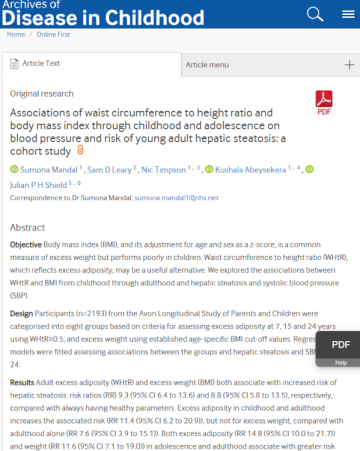Waist-to-height ratio as a tool for predicting metabolic risk
Theme Diet and physical activity
Workstream Population diet and physical activity
Status: This project is complete
The National Institute for Health and Care Excellence (NICE) recommends that people should keep their waist measurement to less than half their height to reduce their risk of potential health problems. This is called the waist-to-height ratio. It can be used, alongside body mass index (BMI), to estimate how much fat a person is carrying around their middle. Knowing this can help with assessing and predicting health risks for type 2 diabetes, hypertension or cardiovascular disease.
NICE recommends using waist-to-height ratio alongside BMI to assess and predict weight-related conditions. However, we don’t know enough about how waist-to-height ratio changes throughout a person’s life to fully understand whether it could be used as an alternative to BMI when trying to predict future health conditions.
Project aims
During this study we explored whether using waist-to-height ratio in childhood could be used together with BMI to:
- Predict the risk of diseases related to central body fat in later life
- Explore if central body fat in childhood contributes to liver disease and high blood pressure in adulthood
To do this, we used data from the Avon Longitudinal Study of Parents and Children (ALSPAC). We followed more than 2,000 participants from childhood into early adulthood, to:
- Chart changes in waist-to-height ratio compared to BMI
- Examine the link between waist-to-height ratio or BMI and blood pressure
- Examine the link between waist-to-height ratio or BMI and liver steatosis (a buildup of fat in the liver)
- Explore if waist-to-height ratio could be used as an alternative measure to predict risk for blood pressure and liver health
What we found
We found that young adults with excess waist size to height, had up to 9 times the risk of developing liver disease compared with those who maintained healthy levels through to early adult life. But those who had excess WHtR or BMI in childhood through to early adulthood were at even higher risk: about 15-times the risk compared to always having healthy levels.
The findings highlight the long-term health effects of childhood weight and body shape. WHtR could offer a simpler and potentially more effective way to identify children at higher risk of future health problems. It might be especially useful in schools or clinics, where a quick and easy measure of risk could help guide early health interventions.
This project was led by Dr Sumona Mandal with Dr Kushala Abeysekera, Dr Sam Leary, Professor Nic Timpson and Professor Julian Hamilton-Shield providing supervision.
